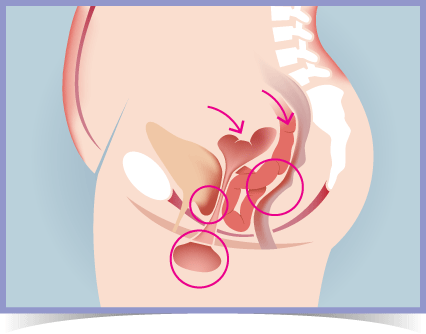What is a Pelvic Organ Prolapse?

A Pelvic Organ Prolapse (POP) is a condition where one or more of the pelvic organs (e.g. uterus, bladder, vagina, rectum) droop from their usual healthy position in a women's pelvis, and fall down towards the vagina.
Muscles, ligaments and skin, in and around the vagina, support and hold the female pelvic organs and tissues in place by acting as a hammock. However, pregnancy, childbirth, ageing, and the menopause, all contribute to the stretching and weakening of these pelvic floor muscles. The result can be a pelvic organ prolapse - where the pelvic organs or even the vagina itself fall out of their normal position. Once one organ begins to droop, you are more likely to experience further prolapses as the organs act as support for each other and often prolapse as a result of the same things.
Many women are understandably embarrassed to discuss this condition, due to its intimate nature and the perceived stigma of the symptoms. But you're far from alone, with 1 in 3 women suffering from a pelvic floor issue during their life time. Around 40% of women will be affected by a vaginal prolapse by the time we reach our 60's, and this figure rises to 50% of us over 50. Studies suggest that with each year, a women becomes 12% more likely to suffer from a severe pelvic organ prolapse due to the natural weakening of the pelvic floor muscles. Unfortunately, once one pelvic organ prolapse has occurred, the same prolapse is likely to occur again.
although not life-threatening, a pelvic organ prolapse can cause severe pain and discomfort, especially in later stages if the prolapse becomes exposed outside of your vagina. A pelvic organ prolapse is associated with multiple health conditions, including urinary and rectal incontinence, discomfort or pain during sex, and commonly the feeling of something falling out of your vagina. Thankfully, mild and moderate pelvic organ prolapses are relatively easy to treat with an adjustment of your lifestyle and the introduction of pelvic floor exercises and other non-surgical treatments.
As with most medical problems, it’s important not to put off treatment. Allowing your prolapse to go untreated for a long period of time leads to even weaker pelvic floor muscles and damage to associated nerves - increasing the risk of a prolapse reoccurring. So avoid unnecessary delays and speak to your doctor if you have any concerns.
How Can I Avoid a Pelvic Organ Prolapse?
Even if you’re young and haven’t had children, adding pelvic floor exercises to your daily routine can prevent a pelvic organ prolapse from occurring.
If you have already fallen victim to a pelvic organ prolapse, you can read more about each common prolapse type below and the specific treatments available. You will notice all pelvic organ prolapses have a common theme - strengthening the pelvic floor.
What Are the Different Types of Pelvic Organ Prolapse?
Take a look at our guides to learn more about the most common types of prolapse a women can experience as a result of a weakened pelvic floor. Each article contains details of the symptoms, a range of preventative measures and what treatment options are available:
- Bladder prolapse - A bladder prolapse is the drooping of the bladder into the front, anterior wall, of the vagina. As such, it can only occur in women. The three main types of bladder prolapse are cystocele, urethrocele and cystourethrocele.
- Vaginal prolapse - A vaginal prolapse is when the vagina itself, falls out of its normal position. It can droop down until it protrudes from the body. It is often followed by further pelvic organ prolapses.
- Rectal prolapse - A rectal prolapse can occur in men and women of all ages. It is the name for the prolapse where the rectum, and rectal tissue, droops and protrudes through the anus.
- Rectocele - Similarly to a rectal prolapse, a rectocele involves the weakening of the rectum and rectal tissue. A rectocele, however, can only occur in women as is in this condition the rectum bulges into the vagina.
- Uterine prolapse - A uterine prolapse is the name for when the uterus weakens and bulges into the vaginal space, and in later stages protrudes outside the vagina. It is commonly followed by cystocele and rectocele prolapses due to the loss of support the uterus naturally provides.
- Cystocele - A type of bladder prolapse, a cystocele is the prolapse of the bladder into the front, anterior wall, of the vagina.
- Urethrocele - A type of bladder prolapse, a urethrocele is the prolapse of the urethra (tube that takes urine from the bladder to the outside of the body) into the vagina.
- Vaginal vault prolapse - A vaginal vault prolapse is experienced when the top part of the vaginal wall loses its strength and droops downwards into the vaginal canal. 72% of women suffering from a vaginal vault prolapse suffer further pelvic organ prolapses.
- Enterocele - An enterocele is the prolapse of the small bowel (small intestine) into the upper wall of the vagina.
- Perineal Descent - Descending perineum syndrome is when the perineum (the area between the anus and the scrotum/vulva) bulges down and prolapses below the bony outlet of the pelvis.
Sources
Farag, K. A. Uzoma, A. (2009) Obstetrics and Gynecology International. Vaginal Vault Prolapse. [online] 275621, p1-9. [viewed 21/03/2019]. Available from: https://www.ncbi.nlm.nih.gov/pmc/articles/PMC2778877/
Royal College of Obstetricians and Gynaecologists. (2013). Information for you, Pelvic organ prolapse [online] Royal College of Obstetricians and Gynaecologists, 2013 [viewed 14/03/2018]. Available from: https://www.rcog.org.uk/globalassets/documents/patients/patient-information-leaflets/gynaecology/pi-pelvic-organ-prolapse.pdf
Royal College of Obstetricians and Gynaecologists. (2018). Menopause and women's health in later life, Pelvic organ prolapse [online] Royal College of Obstetricians and Gynaecologists, 2018 [viewed 14/03/2018]. Available from: https://www.rcog.org.uk/en/patients/menopause/pelvic-organ-prolapse/
Women's Health Concern. (2015). Prolapse: Uterine and vaginal [online] Women's Health Concern, 2015 [viewed 14/03/2018]. Available from: https://www.womens-health-concern.org/help-and-advice/factsheets/prolapse-uterine-vaginal/




